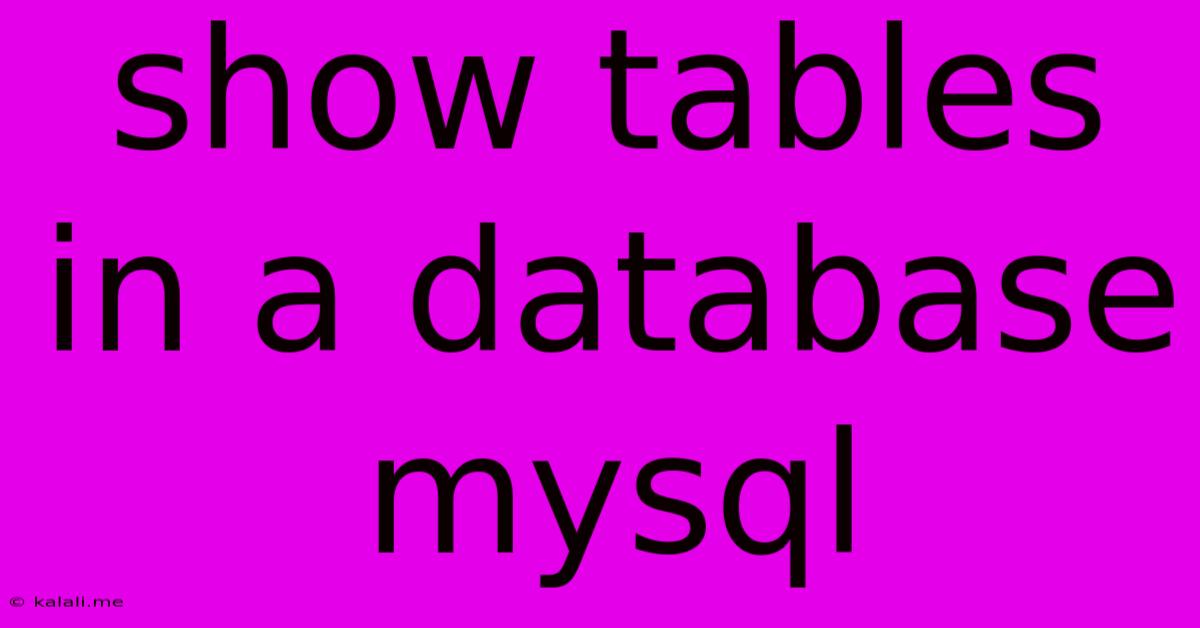Show Tables In A Database Mysql
Kalali
Jun 02, 2025 · 3 min read

Table of Contents
Show Tables in a MySQL Database: A Comprehensive Guide
This guide provides a comprehensive overview of how to effectively list tables within your MySQL database. Whether you're a seasoned database administrator or a beginner just starting out, understanding this fundamental command is crucial for managing your data effectively. This article covers various methods, including using the SHOW TABLES statement and its variations, along with tips for handling large databases and troubleshooting common issues.
The ability to view your database's tables is essential for navigating your data, performing queries, and generally maintaining your database. Knowing which tables exist, and potentially their structure, is the first step in any database operation.
Using the SHOW TABLES Statement
The most straightforward way to list tables in MySQL is using the SHOW TABLES statement. This simple command provides a concise list of all tables within the currently selected database. Here's the basic syntax:
SHOW TABLES;
After connecting to your MySQL server and selecting the desired database using USE database_name;, executing this command will output a list of all tables. Simple and effective!
Specifying a Database: The FROM Clause
While SHOW TABLES; works well when you're already in the correct database, you can also specify the database directly using the FROM clause. This eliminates the need for a separate USE statement.
SHOW TABLES FROM database_name;
Replace database_name with the actual name of your database. This method is particularly useful when working with multiple databases simultaneously or scripting database operations. It increases code clarity and reduces potential errors from forgetting to select the right database.
Using INFORMATION_SCHEMA for Advanced Table Information
For more detailed information than just table names, you can leverage the INFORMATION_SCHEMA database, a metadatabase containing information about your MySQL server's structure. This allows you to query for tables and their attributes, including engine type, character set, and creation time.
This offers a more powerful approach, allowing you to filter and sort results based on specific table characteristics. For example, you might want to list only tables with a specific engine type:
SELECT TABLE_NAME
FROM INFORMATION_SCHEMA.TABLES
WHERE TABLE_SCHEMA = 'database_name'
AND TABLE_TYPE = 'BASE TABLE';
This query retrieves the names of all base tables (as opposed to views) from the specified database. You can adapt this query to include other columns from INFORMATION_SCHEMA.TABLES to gather more detailed table information.
Handling Large Databases: Optimization Techniques
When dealing with databases containing hundreds or thousands of tables, simply displaying all table names might become less efficient. In such cases, consider optimizing your approach:
- Filtering: Use
WHEREclauses in your queries to filter the results based on specific criteria, reducing the data returned. - Pagination: Implement pagination to retrieve and display results in manageable chunks, improving performance and usability.
- Indexing: Ensure that relevant indexes exist on the
INFORMATION_SCHEMAtables to speed up queries. This is especially beneficial for large databases.
Troubleshooting Common Issues
- Incorrect Database Selection: Double-check that you've selected the correct database before running
SHOW TABLES. - Permissions: Ensure your MySQL user has the necessary privileges to access the database and view its tables.
- Typos: Verify the accuracy of your database and table names – even a small typo can lead to errors.
By understanding and implementing these techniques, you can efficiently manage your MySQL databases, regardless of their size or complexity. Mastering these commands will significantly improve your database administration skills and workflow. Remember to always back up your data before making any significant changes to your database structure.
Latest Posts
Latest Posts
-
How To Fix Slow Draining Sink
Jun 04, 2025
-
She Make Him Grow During A Photoshoot
Jun 04, 2025
-
Why Do Roosters Crow All Day
Jun 04, 2025
-
Is Red Positive On A Battery
Jun 04, 2025
-
Can Sunlight Affect Garage Door Sensors
Jun 04, 2025
Related Post
Thank you for visiting our website which covers about Show Tables In A Database Mysql . We hope the information provided has been useful to you. Feel free to contact us if you have any questions or need further assistance. See you next time and don't miss to bookmark.